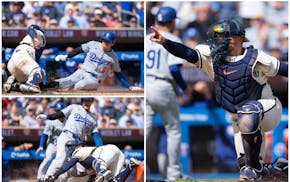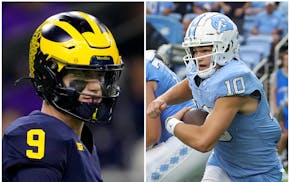By any statistical metric, college football in its current state resembles a video game in terms of offensive firepower.
In the 2013 season, 57 teams averaged at least 30 points per game. Two teams — Baylor and Florida State — morphed into a basketball squad by scoring 50-plus points per game.
More than 70 teams averaged at least 400 yards of offense, including a dozen who topped 500 yards per game.
Against that backdrop, something strange has happened in Dinkytown. The Gophers actually play defense now.
As Jerry Kill enters his fourth season in charge, any conversation about his program rebuild should focus on his emphasis on defense.
Defense has become a priority for the Gophers, not an afterthought, which is why Kill's team won eight games last season and deserves to be taken seriously as a program on the rise.
Their defense is no longer an eyesore like an ugly beater sitting in the driveway. Historically, the words Gophers and defense used in the same sentence usually included a punch line. That's starting to change.
The Gophers finished 25th nationally in scoring defense last season, which looks even more impressive when compared to past performances.
In 2011, the Gophers ranked 93rd in points allowed. They finished 98th the previous season.
The 2007 season — the first under Tim Brewster — became downright nauseating to watch. No Division I team allowed more yards than the Gophers, who also finished 109th in scoring defense and 115th in pass defense.
That defense got carved up more than a Christmas ham.
Former coach Glen Mason constructed one of the most statistically prolific rushing offenses in college football history, but defensive shortcomings prevented his teams from fully capitalizing on that offensive success. Almost unfathomably, Mason's teams lost two games in which they rushed for more than 400 yards.
It's refreshing to see competent defense on display, as opposed to a unit just hanging on for dear life. In Big Ten games last season, the Gophers allowed 23.5 points per game, only one point more than Ohio State.
They held Nebraska to 23 points, Wisconsin to 20, Michigan State to 14.
For once, it was the offense that let them down.
"We were disappointed with the two losses [to Wisconsin and Michigan State]," defensive coordinator Tracy Claeys said, "but for the first time, whether you want to say physically or toughness-wise, we lined up and played against those two teams with a chance to win in the fourth quarter. I think that gave our kids a lot of confidence."
Here's further proof of that: The Gophers lost their two best defensive players — Ra'Shede Hageman and Brock Vereen — to the NFL, and the feeling internally is that their defense will be just as good, if not better, particularly in the secondary.
Consistency will be the ultimate gauge of whether this is just a temporary spike. The Gophers must continue to build on what they've started and avoid any significant regress. But several factors lend credence to this foreign notion that the Gophers can rely on defense as their bedrock.
Start first with coaching. Kill set the template by preaching defense. Claeys executes that vision with a sharp football mind and hard-nosed approach. Claeys' defense exhibits a measure of toughness — both physical and mental — that hasn't always been evident in the past.
If the Gophers put forth a similar defensive performance this season, Claeys' name undoubtedly will surface in head coaching searches next offseason.
Coaches often say that talent makes them look better, and the upgrades in that area are unmistakable. Regardless of what those annual recruiting rankings suggest, the Gophers have more defensive players who pass the eye test now. They look like legitimate Big Ten players in size and speed and ability. Their depth is better, too.
Kill covets length (wingspan/reach) in recruiting and the Gophers have improved their overall speed on defense. Those things allow them to be in better position to make plays, especially in the secondary, which has become an area of strength and was picked as the fourth-best in the Big Ten by one preseason publication.
"I know we may not be as big as some teams," Claeys said, "but I still would rather have guys who can run and tough guys."
Now if they can only find some playmakers on offense.
Sounds strange, doesn't it?
Chip Scoggins • chip.scoggins@startribune.com
Scoggins: 'Wait one more year' can't be the Wild's plan. Thankfully, it isn't.

Scoggins: Finch feeling heat of the Suns as playoff battle looms
Scoggins: Why 'championship or bust' fits these Wolves

Scoggins: Anatomy of a game-saving play as Correa throws out Ohtani

